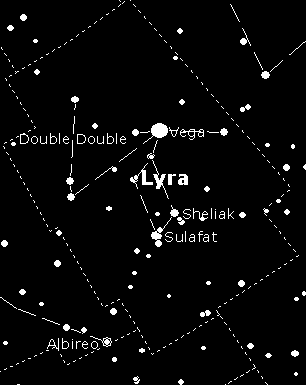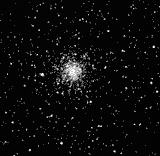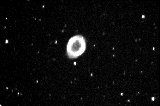
Lyra
Abbreviation: Lyr
Genitive: Lyrae
Right Ascension: 18.84 hours
Declination: 36.82 degrees
Lyra the Lyre or Harp is the instrument invented by Hermes (Mercury) and given to Apollo his half-brother, who in turn gave it to his son Orpheus, the musician of the Argonauts.
In ancient times, the harp was placed in the claws of Aquila.
Best Known Stars
(Yale Bright Star Catalog)| Common Name or Bayer Number 1 |
RA | DEC | Magnitude 2 |
|---|---|---|---|
| VEGA | 18.00:36.00:56.33 | +38.00:47.00:1.17 | 0.03 |
| SULAFAT | 18.00:58.00:56.62 | +32.00:41.00:22.42 | 3.24 |
| SHELIAK | 18.00:50.00:4.80 | +33.00:21.00:45.65 | 3.30 |
| R LYRAE | 18.00:55.00:20.11 | +43.00:56.00:45.99 | 3.90 |
| THE LYR | 19.00:16.00:22.09 | +38.00:8.00:1.46 | 4.36 |
| IOT LYR | 19.00:7.00:18.12 | +36.00:6.00:0.61 | 5.28 |
Deep Sky Objects
(PAS Catalog)Delta Lyr
Epsolon Lyr

M-56

M-57
M-57 The Ring Nebula. This one of my
favorite objects, and was the first object I looked at through my first
telescope, bypassing even Saturn. The ring shape is evident even at low
powers, and holds up well to magnification. This showpiece object is bright
enough to be seen even in severely light polluted area.
Other Deep Sky Objects
(Saguaro Astronomy Club Catalog)| Object | R.A. | Dec. | Object Type 3 | Mag. | Uranometria | Tirion |
|---|---|---|---|---|---|---|
| Steph 1 | 18 53.5 | +36 55 | OPNCL | 03.8 | 117 | 08 |
| NGC 6720 | 18 53.6 | +33 02 | PLNNB | 09 | 117 | 08 |
| NGC 6779 | 19 16.6 | +30 11 | GLOCL | 08.3 | 118 | 08 |
| NGC 6791 | 19 20.7 | +37 51 | OPNCL | 09.5 | 118 | 08 |
Variable Stars
(General Catalog of Variable Stars)| GCVS ID | R.A. (hh mm ss.ss) |
Dec. (deg mm ss) |
Variable Type 4 | Mag. Min | Mag. Max |
|---|---|---|---|---|---|
| R Lyr | 18.00:53.00:48.70 | +43.00:52.00:46.00 | SRB | 5.00 | 3.88 |
| XY Lyr | 18.00:36.00:27.30 | +39.00:37.00:23.00 | LC | 6.35 | 5.80 |
| V0398 Lyr | 19.00:6.00:31.40 | +39.00:4.00:27.00 | LB | 7.57 | 7.30 |
| V0471 Lyr | 19.00:9.00:50.80 | +31.00:11.00:56.00 | ACV | 5.98 | 5.91 |
| V0473 Lyr | 19.00:13.00:59.10 | +27.00:50.00:14.00 | DCEPS: | 6.35 | 5.99 |
| V0478 Lyr | 19.00:5.00:35.50 | +30.00:10.00:24.00 | RS | 0.03 | 7.63 |
| alf Lyr | 18.00:35.00:14.70 | +38.00:44.00:10.00 | DSCTC | 0.07 | -0.02 |
| bet Lyr | 18.00:48.00:13.90 | +33.00:18.00:13.00 | EB | 4.36 | 3.25 |
| del 2 Lyr | 18.00:52.00:45.20 | +36.00:50.00:3.00 | SRC: | 4.33 | 4.22 |
Double Stars
(Saguaro Astronomy Club Catalog)| Name | R.A. (hh mm.m) |
Dec. (deg mm) |
Mag 5 | Sep 6 | PA 7 | Tirion | Uranometria |
|---|---|---|---|---|---|---|---|
| STF 2351 | 18 36.2 | 41 17 | 7.7, 7.7 | 5.10 | 340 | 8 | 82 |
| STF 37 | 18 44.3 | 39 40 | 4.6, 4.9 | 200.90 | 172 | 8 | 82/ 83/ 117 |
| STF 37 | 18 44.3 | 39 40 | 5.1, 5.4 | 210.70 | 173 | 8 | 82/ 83/ 117 |
| STF 37 | 18 44.3 | 39 40 | 6.1, 5.1 | 208.90 | 172 | 8 | 82/ 83/ 117 |
| STF 37 | 18 44.3 | 39 40 | 6.1, 5.4 | 212.40 | 172 | 8 | 82/ 83/ 117 |
| STF 2382 | 18 44.3 | 39 40 | 5.1, 6.1 | 2.60 | 356 | 8 | 82/ 83/ 117 |
| STF 2383 | 18 44.3 | 39 40 | 5.1, 5.4 | 2.30 | 92 | 8 | 82/ 83/ 117 |
| STF 38 | 18 44.7 | 37 36 | 4.3, 5.9 | 43.70 | 150 | 8 | 117 |
| BETA LYR | 18 50.0 | 33 24 | 3.5, 7.0 | 47.00 | 149 | 8 | 117 |
| STG 525 | 18 54.9 | 33 57 | 6.1, 7.8 | 45.40 | 350 | 8 | 117 |
| S 2487 | 19 13.7 | 39 12 | 4.0, 8.0 | 28.00 | 83 | 8 | 83/ 118 |
| STT 181 | 19 20.1 | 26 39 | 7.6, 7.4 | 60.10 | 2 | 8 | 161 |